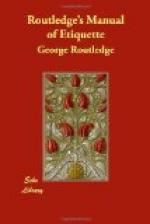Difference of Religion.
Where the bride and bridegroom are of different religions, the marriage is usually first celebrated in the church of that communion to which the husband belongs; the second celebration should immediately follow, and upon the same day. Some, however, regard it as duly deferential to the bride’s feelings that the first ceremony should be performed in her own communion. There is a notion prevalent, that in the case of a marriage between Roman Catholics and Protestants, the ceremony must necessarily be first performed in a Protestant church. This is erroneous—the order of the twofold marriage is, in a legal point of view, of no moment, so long as it takes place on the same day.
The Return to the Vestry.
On the completion of the ceremony the bride is led to the vestry by the bridegroom. The bridesmaids and bridegroomsmen follow, the principals of each taking the lead; then the father of the bride, followed by the father and mother of the bridegroom, and the rest of the company.
The Registry of the Marriage.
The husband signs first; then the bride-wife, for the last time in her maiden name; next the father of the bride, and the mother, if present; then the father and mother of the bridegroom, if present; next the bridesmaids and the bridegroomsmen; then such of the rest of the company as may desire to be on the record as witnesses. All the names must be signed in full. The certificate of the marriage is then handed to the bride, and should be carefully preserved in her own possession.
The Wedding Favours.
Meanwhile, outside the church, as soon as the ceremony is completed—and not before, for it is regarded as unfortunate—a box of the wedding favours is opened, and every servant in waiting takes care to pin one on the right side of his hat, while the coachmen, too, ornament therewith the ears of their horses. Inside the church the wedding favours are also distributed, and a gay, gallant, and animated scene ensues, as each bridesmaid pins on to the coat of each bridegroomsman a wedding favour, which he returns by pinning one also on her shoulder. Every “favour” is carefully furnished with two pins for this purpose; and it is amazing to see the flutter, the coquettish smiling, and the frequent pricking of fingers, which the performance of this piquant and pleasant duty of the wedding bachelors and ladies “in waiting” does occasion!
The Return Home.
The bridegroom now leads the bride out of the church, and the happy pair return homeward in the first carriage. The father and mother follow in the next. The rest “stand not on the order of their going,” but start off in such wise as they can best contrive.
The Wedding Breakfast.




